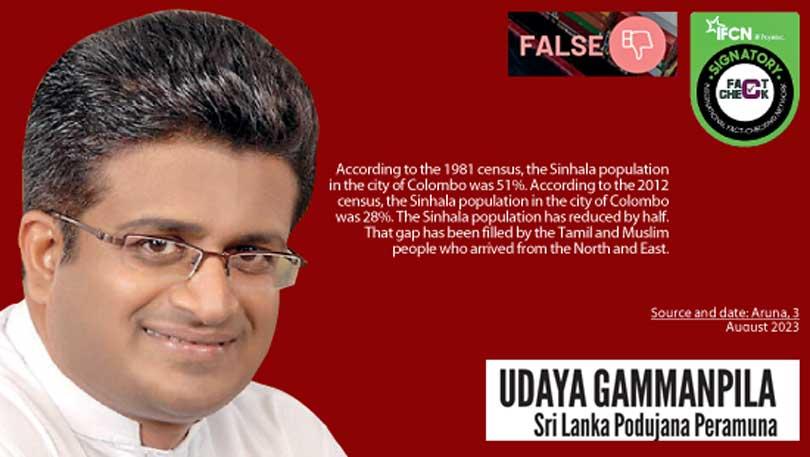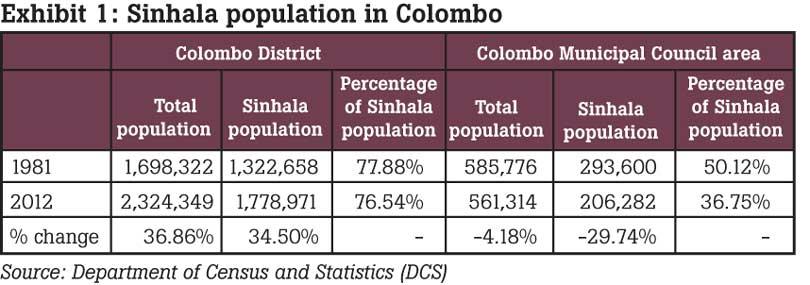14 Sep 2023 - {{hitsCtrl.values.hits}}

 To evaluate the MP’s claim, FactCheck.lk consulted the 1981 and 2012 censuses from the Department of Census and Statistics (DCS). The census does not define the “City of Colombo.” The 2012 census only provides data at the district level and Divisional Secretariat Division (DSD) level. The 1981 census provides data at a district level and Assistant Government Agent (AGA) division level, which were precursors to DSDs.
To evaluate the MP’s claim, FactCheck.lk consulted the 1981 and 2012 censuses from the Department of Census and Statistics (DCS). The census does not define the “City of Colombo.” The 2012 census only provides data at the district level and Divisional Secretariat Division (DSD) level. The 1981 census provides data at a district level and Assistant Government Agent (AGA) division level, which were precursors to DSDs.
Therefore, to provide a full picture of the scope of the MP’s claim, FactCheck.lk considered two areas: (i) Colombo District and (ii) the AGA division or DSDs that best align with the Colombo Municipal Council area—the Colombo AGA in 1981, and Colombo and Thimbirigasyaya DSDs for 2012.
DCS data, as illustrated in Exhibit 1, indicates that the Sinhala population in the Colombo Municipal Council area decreased between 1981 and 2012. This reduction was by less than thirty per cent (29.7%) and not by half as the MP claims. The 2012 Sinhala population in the city was also 36.75%, which is much higher than the 28% claimed by the MP.
The MP’s mistake can be traced to the fact that the geographic area referred to as the Colombo Municipal Council area in 1981 was subsequently split into two divisions called Colombo and Thimbirigasyaya. He seems to have compared the population in the whole area in 1981 against the population in part of the area (Colombo DSD only) in 2012.
The MP’s focus on the Colombo Municipal Area is also inappropriate for the racially tinged, alarmist concern that he raises—about the Sinhala population being marginalised in Colombo by an influx of Tamil and Muslim people. As cities develop the wealthy with private transport tend to move towards residential suburbs, which become part of a greater metropolitan area of the city. In Colombo, this greater area now includes not just the previous municipal limits, but also areas such as Sri Jayewardenepura Kotte (the new capital), Dehiwala, and Mount Lavinia.
At a district level, including the greater Colombo metropolitan area, the population of Sinhala people did not decrease but grew by over 450,000 (a 34.5% increase) between 1981 and 2012. The overall share of the Sinhala population did decrease, but rather marginally from 77.88% to 76.54%.
The MP makes two mistakes: (1) He mistakenly compares the Sinhala population in the Colombo Municipal Council area in 1981 against the population in the much smaller area of the Colombo DSD division in 2012, and (2) he fails to recognise that the larger Colombo metropolitan area and district—which is the more appropriate reference point for his evaluation—there has been a huge numerical increase (not decrease) in the Sinhala population and only a marginal decrease as a percentage of the population.
Therefore, we classify his statement as FALSE.
*FactCheck.lk’s verdict is based on the most recent information that is publicly accessible. As with every fact check, if new information becomes available, FactCheck.lk will revisit the assessment.

FactCheck is a platform run by Verité Research.
For comments, suggestions and feedback, please visit www.factcheck.lk.
28 Apr 2024 3 hours ago
28 Apr 2024 5 hours ago
28 Apr 2024 6 hours ago
28 Apr 2024 6 hours ago
28 Apr 2024 9 hours ago